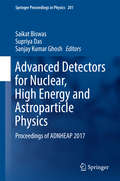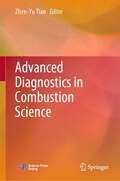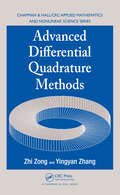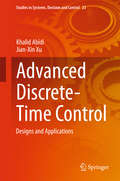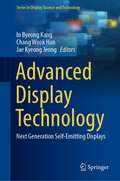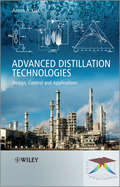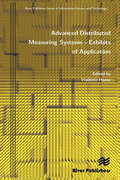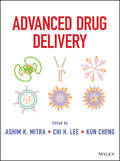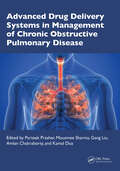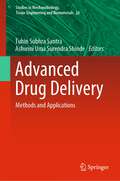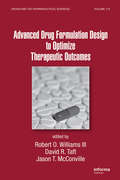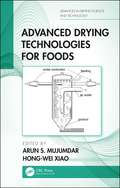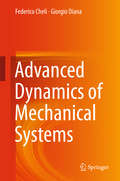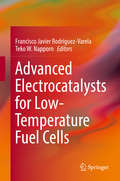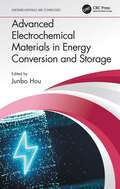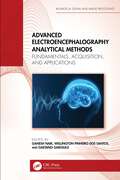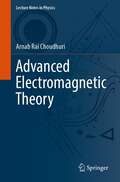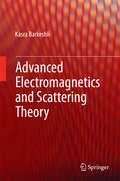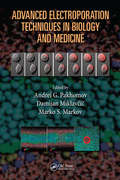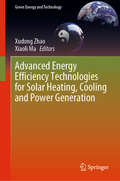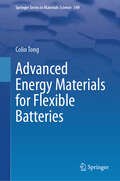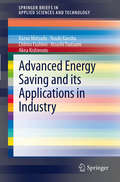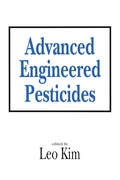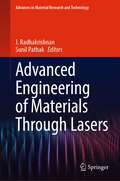- Table View
- List View
Advanced Detectors for Nuclear, High Energy and Astroparticle Physics: Proceedings Of Adnheap 2017 (Springer Proceedings In Physics #201)
by Saikat Biswas Supriya Das Sanjay Kumar GhoshThe book presents high-quality papers presented at a national conference on ‘Advanced Detectors for Nuclear, High Energy and Astroparticle Physics’. The conference was organized to commemorate 100 years of Bose Institute. The book is based on the theme of the conference and provides a clear picture of basics and advancement of detectors for nuclear physics, high-energy physics and astroparticle physics together. The topics covered in the book include detectors for accelerator-based high energy physics; detectors for non-accelerator particle physics; nuclear physics detectors; detection techniques in astroparticle physics and dark matter; and applications and simulations. The book will be a good reference for researchers and industrial personnel working in the area of nuclear and astroparticle physics.
Advanced Diagnostics in Combustion Science
by Zhen-Yu TianThis textbook, supported by the Textbook Publishing Center of University of Chinese Academy of Sciences, provides a fundamental introduction to advanced diagnostics techniques for graduate students majoring in combustion science, chemistry, and chemical engineering-related subjects. The textbook provides an overview with respect to the spectroscopic methods in advanced diagnostics techniques such as gas chromatography/mass spectrometry, thermochemical analysis, Raman scattering, and nuclear magnetic resonance. It then describes the comprehensive basic theory, equipment structure, and testing methods of diagnostic techniques and summarizes the analysis methods commonly used in combustion chemical reaction processes. This can provide graduate students with important guidance and comprehensive understanding of diagnostics techniques before performing physics and chemistry experiments. In addition, it provides an introduction into using common mathematical and graphics packages for students to acquire and practice the tools to comply with international standards. The textbook is concise and illustrative and includes hot issues and current progress of diagnostics. In addition, exercises and questions are included at the end of each chapter for students to practice and gain hands-on experience. Given its scope, the textbook is of great benefit to graduate students in combustion chemistry and engineering and other related areas such as environmental science, optical engineering, and thermal science and is also beneficial for researchers with interdisciplinary backgrounds.
Advanced Differential Quadrature Methods (Chapman & Hall/CRC Applied Mathematics & Nonlinear Science)
by Zhi Zong Yingyan ZhangModern Tools to Perform Numerical DifferentiationThe original direct differential quadrature (DQ) method has been known to fail for problems with strong nonlinearity and material discontinuity as well as for problems involving singularity, irregularity, and multiple scales. But now researchers in applied mathematics, computational mechanics, and en
Advanced Discrete-Time Control: Designs and Applications (Studies in Systems, Decision and Control #23)
by Khalid Abidi Jian-Xin XuThis book covers a wide spectrum of systems such as linear and nonlinear multivariable systems as well as control problems such as disturbance, uncertainty and time-delays. The purpose of this book is to provide researchers and practitioners a manual for the design and application of advanced discrete-time controllers. The book presents six different control approaches depending on the type of system and control problem. The first and second approaches are based on Sliding Mode control (SMC) theory and are intended for linear systems with exogenous disturbances. The third and fourth approaches are based on adaptive control theory and are aimed at linear/nonlinear systems with periodically varying parametric uncertainty or systems with input delay. The fifth approach is based on Iterative learning control (ILC) theory and is aimed at uncertain linear/nonlinear systems with repeatable tasks and the final approach is based on fuzzy logic control (FLC) and is intended for highly uncertain systems with heuristic control knowledge. Detailed numerical examples are provided in each chapter to illustrate the design procedure for each control method. A number of practical control applications are also presented to show the problem solving process and effectiveness with the advanced discrete-time control approaches introduced in this book.
Advanced Display Technology: Next Generation Self-Emitting Displays (Series in Display Science and Technology)
by In Byeong Kang Chang Wook Han Jae Kyeong JeongThis book provides a comprehensive and up-to-date guide to the AMOLED technologies and applications which have become industry standard in a range of devices, from small mobile displays to large televisions. Unlike other books on the topic, which cover the fundamentals, materials, processing, and manufacturing of OLEDs, this one-stop book discusses the core components, such as TFT backplanes, OLED materials and devices, and driving schematics together in one volume with chapters written by experts from leading international companies in the field of OLED materials and OLED TVs. It also examines emerging areas, such as micro-LEDs, displays using quantum dots, and AR & VR displays. Presenting the latest research trends as well as the basic principles of each topic, this book is intended for undergraduate and postgraduate students taking display-related courses, new researchers, and engineers in related fields.
Advanced Distillation Technologies
by Anton A. KissDistillation has historically been the main method for separating mixtures in the chemical process industry. However, despite the flexibility and widespread use of distillation processes, they still remain extremely energy inefficient. Increased optimization and novel distillation concepts can deliver substantial benefits, not just in terms of significantly lower energy use, but also in reducing capital investment and improving eco-efficiency. While likely to remain the separation technology of choice for the next few decades, there is no doubt that distillation technologies need to make radical changes in order to meet the demands of the energy-conscious society.Advanced Distillation Technologies: Design, Control and Applications gives a deep and broad insight into integrated separations using non-conventional arrangements, including both current and upcoming process intensification technologies. It includes:Key concepts in distillation technologyPrinciples of design, control, sizing and economics of distillationDividing-wall column (DWC) - design, configurations, optimal operation and energy efficient and advanced controlDWC applications in ternary separations, azeotropic, extractive and reactive distillationHeat integrated distillation column (HIDiC) - design, equipment and configurationsHeat-pump assisted applications (MVR, TVR, AHP, CHRP, TAHP and others)Cyclic distillation technology - concepts, modeling approach, design and control issuesReactive distillation - fundamentals, equipment, applications, feasibility schemeResults of rigorous simulations in Mathworks Matlab & Simulink, Aspen Plus, Dynamics and Custom ModelerContaining abundant examples and industrial case studies, this is a unique resource that tackles the most advanced distillation technologies - all the way from the conceptual design to practical implementation.The author of Advanced Distillation Technologies, Dr. Ir. Anton A. Kiss, has been awarded the Hoogewerff Jongerenprijs 2013. Find out more (website in Dutch)...
Advanced Distributed Measuring Systems - Exhibits of Application
by Prof. Vladimír HaaszMeasuring systems are an essential part of all automated production systems, they also serve to ensure quality of production or they are used to assure the reliability and safety in various areas. The same applies in principle likewise for fields of telecommunication, energy production and distribution, health care etc. Similarly no serious scientific research in the field of natural and technical sciences can be performed without objective data about the investigated object, which are usually acquired using measuring system. Demands on the speed and accuracy of measurement increase in all areas in general. These are the grounds for publishing this book.The book "Advanced distributed measuring systems - exhibits of application" offers 8 up-to-date examples of typical laboratory, industrial and biomedical applications of advanced measuring and information systems including virtual instrumentation. It arose based on the most interesting papers from this area published at IDAACS'2011 conference. However, single chapters include not only system design solution in wider context but also relevant theoretical parts, achieved results and possible future ways of design and development.Technical topics discussed in the book include:• embedded applications;• small distributed systems;• automotive distributed system;• distributed monitoring systems based on wireless networks;• synchronisation in large DAQ systems;• virtual instrumentation."Advanced distributed measuring systems - exhibits of application" is ideal for personnel of firms deals with control systems, automotive electronics, airspace instrumentation, health care technology etc. as well as academic staff and postgraduate students in electrical, control and computer engineering.
Advanced Drug Delivery
by Kun Cheng Chi H. Lee Ashim MitraProvides both fundamentals and new and emerging applications Advanced Drug Delivery brings readers fully up to date with the state of the science, presenting the basics, formulation strategies, and therapeutic applications of advanced drug delivery. The book demonstrates how core concepts of pharmaceutical sciences, chemistry, and molecular biology can be combined and applied in order to spark novel ideas to design and develop advanced drug delivery systems for the treatment of a broad range of human diseases. Advanced Drug Delivery features contributions from an international team of pharmaceutical scientists. Chapters reflect a thorough review and analysis of the literature as well as the authors' firsthand experience developing drug delivery systems. The book is divided into four parts: Part I, Introduction and Basics of Advanced Drug Delivery, explores physiological barriers, stability, transporters, and biomaterials in drug delivery Part II, Strategies for Advanced Drug Delivery, offers tested and proven strategies for advanced delivery of both small molecules and macromolecules Part III, Translational Research of Advanced Drug Delivery, focuses on regulatory considerations and translational applications of advanced drug delivery systems for the treatment of cardiovascular diseases, cancer, sexually transmitted diseases, ophthalmic diseases, and brain diseases Part IV, Future Applications of Advanced Drug Delivery in Emerging Research Areas, examines stem cell research, cell-based therapeutics, tissue engineering, and molecular imaging Each chapter provides objectives and assessment questions to help readers grasp key concepts and assess their knowledge as they progress through the book. Advanced Drug Delivery is recommended for graduates and upper-level undergraduates in the pharmaceutical sciences who need a solid foundation in the basics. It is also recommended for pharmaceutical professionals who want to take advantage of new and emerging applications in advanced drug delivery systems.
Advanced Drug Delivery Strategies for Targeting Chronic Inflammatory Lung Diseases
by Dinesh Kumar Chellappan Kavita Pabreja Md. FaiyazuddinThis book describes the growing clinical and healthcare relevance of nano-therapeutics in treating respiratory diseases. It begins with a brief introduction on the different types of nanoparticles in respiratory disease conditions. It further discusses the current trends in understanding the disease pathology using different in vitro and in vivo models, which are important towards the onsite clinical applications and development of new therapeutics. The book includes exciting topics such as formulation of these nanoparticles, targeting various organelles etc. It also describes the future prospects and challenges in the field. Different chapters are written by researchers actively working in the area of pulmonary diseases. This book is designed to address the requirements of both beginners and specialized scientists involved in pulmonary research. The contents include basic concepts followed by advanced state-of-art monitoring and treatment of diseases. The book is meant for researchers and industry experts in nanotechnology, pharmaceutical sciences and drug design.
Advanced Drug Delivery Systems in Management of Chronic Obstructive Pulmonary Disease
by Gang Liu Kamal Dua Amlan Chakraborty Parteek Prasher Mousmee SharmaThis book offers a comprehensive overview of the epidemiology, etiology, and pathophysiology of chronic obstructive pulmonary disease (COPD). It addresses the limitations of existing drug delivery methods and explores advanced delivery systems to overcome these challenges, providing an exhaustive account of their intricate mechanisms. The introductory chapters elucidate pathways responsible for COPD progression, followed by a detailed analysis of established biomarkers and potential targets in contemporary COPD therapy. Subsequent chapters provide insights into ongoing treatment modalities, their efficacy, drawbacks, and prospective solutions to counter the setbacks of COPD therapy. The subsequent section covers state-of-the-art drug delivery technologies and novel drug formulations designed to enhance drug deposition and absorption in COPD lungs. It further explores a methodical yet coordinated explanation of targeted personalized therapies and emerging approaches, including nanoparticles, polymeric carriers, and vesicular delivery systems. Toward the end, the book discusses ongoing and completed clinical trials encompassing the management of COPD through advanced drug delivery approaches. It serves as a valuable resource for professionals, scientists, academicians, and clinicians specializing in respiratory health. Provides an in-depth understanding of the epidemiology, etiology, and pathophysiology of Chronic Obstructive Pulmonary Disease (COPD) Delve into pathways responsible for COPD progression, conducting a detailed analysis of established biomarkers and potential targets in contemporary COPD therapy Offer insights into ongoing treatment modalities, evaluating their efficacy, drawbacks, and proposing prospective solutions to counter the setbacks of COPD therapy Systematically organizes information on state-of-the-art drug delivery technologies and novel formulations designed to enhance drug deposition and absorption in COPD lungs Presents a methodical explanation of targeted personalized therapies and emerging approaches, including nanoparticles, polymeric carriers, and vesicular delivery systems
Advanced Drug Delivery: Methods and Applications (Studies in Mechanobiology, Tissue Engineering and Biomaterials #26)
by Tuhin Subhra Santra Ashwini Uma Surendra ShindeThis book provides an overview of various drug delivery systems at the cellular level including biological, chemical methods, and most importantly physical methods such as photoporation, electroporation, mechanoporation, and device-based techniques (e.g., microfluidics), as well as organism-level techniques including nanomaterials, biomaterials, and transdermal. Drug delivery (DD) can be defined as the method and route by which an active pharmaceutical ingredient (API) is administered to promote its desired pharmacological effect and/or convenience and/or to reduce adverse effects. Drug delivery systems are developed to maximize drug efficacy and minimize side effects. As drug delivery technologies improve, the drug becomes safer and more comfortable for patients to use. During the last seven decades, extraordinary progress has been made in drug delivery technologies, such as systems for long-term delivery for months and years, localized delivery, and targeted delivery. The advances, however, will face the next phase considering the future technologies that we need to overcome many physicochemical barriers for new formulation development and biological unknowns for treating various diseases. Thus, various technologies are built at a single-cell level as well as an organism level. This book is useful at the university level for graduate courses or research studies and biotechnology-based companies with research and development on cell-based analysis, diagnosis, or drug screening. This book is also very useful for researchers in drug delivery technologies, which came in frontier research for the past decade.
Advanced Drug Formulation Design to Optimize Therapeutic Outcomes (Drugs and the Pharmaceutical Sciences)
by Robert O. Williams III David R. Taft Jason T. McConvilleThis title demonstrates how advanced formulation designs and delivery technologies can be used to improve drug efficacy and treatment outcomes in particular therapeutic categories or disease states. It discusses nanoparticle systems for cancer treatments, and also presents cutting edge immono-regulation agents for transplantation and the local targ
Advanced Drying Technologies for Foods (Advances in Drying Science and Technology)
by Arun S. Mujumdar Hong-Wei XiaoThe goal of all drying research and development is to develop cost-effective innovative processes that yield high-quality dried products with less energy consumption and reduced environmental impact. With the literature on drying widely scattered, Advanced Drying Technologies for Foods compiles under one cover concise, authoritative, up-to-date assessments of modern drying technologies applied to foods. This book assembles a number of internationally recognized experts to provide critical reviews of advanced drying technologies, their merits and limitations, application areas and research opportunities for further development. Features: Provides critical reviews of advanced drying technologies Discusses the merits and limitations of a variety of food drying technologies Explains drying kinetics, energy consumption and quality of food products Reviews the principles and recent applications of superheated steam drying The first four chapters deal with recent developments in field-assisted drying technologies. These include drying techniques with the utilization of electromagnetic fields to deliver energy required for drying, for example, microwave drying, radio frequency drying, electrohydrodynamic drying, and infrared radiation drying. The remainder of this book covers a wide assortment of recently developed technologies, which include pulse drying, swell drying, impinging stream drying, and selected advances in spray drying. The final chapter includes some innovative technologies which are gaining ground and are covered in depth in a number of review articles and handbooks, and hence covered briefly in the interest completeness. This book is a valuable reference work for researchers in academia as well as industry and will encourage further research and development and innovations in food drying technologies.
Advanced Dynamics of Mechanical Systems
by Federico Cheli Giorgio DianaThis book introduces a general approach for schematization of mechanical systems with rigid and deformable bodies. It proposes a systems approach to reproduce the interaction of the mechanical system with different force fields such as those due to the action of fluids or contact forces between bodies, i. e. , with forces dependent on the system states, introducing the concepts of the stability of motion. In the first part of the text mechanical systems with one or more degrees of freedom with large motion and subsequently perturbed in the neighborhood of the steady state position are analyzed. Both discrete and continuous systems (modal approach, finite elements) are analyzed. The second part is devoted to the study of mechanical systems subject to force fields, the rotor dynamics, techniques of experimental identification of the parameters and random excitations. The book will be especially valuable for students of engineering courses in Mechanical Systems, Aerospace, Automation and Energy but will also be useful for professionals. The book is made accessible to the widest possible audience by numerous, solved examples and diagrams that apply the principles to real engineering applications.
Advanced Electrocatalysts for Low-Temperature Fuel Cells
by Francisco Javier Rodríguez-Varela Teko W. NappornThis book introduces the reader to the state of the art in nanostructured anode and cathode electrocatalysts for low-temperature acid and alkaline fuel cells. It explores the electrocatalysis of anode (oxidation of organic molecules) and cathode (oxygen reduction) reactions. It also offers insights into metal-carbon interactions, correlating them with the catalytic activity of the electrochemical reactions. The book explores the electrocatalytic behaviour of materials based on noble metals and their alloys, as well as metal-metal oxides and metal-free nanostructures. It also discusses the surface and structural modification of carbon supports to enhance the catalytic activity of electrocatalysts for fuel-cell reactions.
Advanced Electrochemical Materials in Energy Conversion and Storage (Emerging Materials and Technologies)
by Junbo HouAdvanced Electrochemical Materials in Energy Conversion and Storage focuses on novel electrochemical materials particularly designed for specific energy applications. It presents the relationship of materials properties, state-of-the-art processing, and device performance and sheds light on the research, development, and deployment (RD&D) trend of emerging materials and technologies in this field. Emphasizes electrochemical materials applied in PEM fuel cells and water splitting Summarizes anode, cathode, electrolyte, and additive materials developed for lithium-ion batteries and reviews other batteries, including lithium air, lithium sulfur, sodium and potassium, and multivalent ion batteries Discusses advanced carbon materials for supercapacitors Highlights catalyst design and development for CO2RR and fundamentals of proton facilitated reduction reactions With a cross-disciplinary approach, this work will be of interest to scientists and engineers across chemical engineering, mechanical engineering, materials science, chemistry, physics, and other disciplines working to advance electrochemical energy conversion and storage capabilities and applications.
Advanced Electroencephalography Analytical Methods: Fundamentals, Acquisition, and Applications (Biomedical Signal and Image Processing)
by Ganesh Naik Santos, Wellington Pinheiro dos Gaetano GargiuloAdvanced Electroencephalography Analytical Methods: Fundamentals, Acquisition, and Applications presents the theoretical basis and applications of electroencephalography (EEG) signals in neuroscience, involving signal analysis, processing, signal acquisition, representation, and applications of EEG signal analysis using non-linear approaches and machine learning. It explains principles of neurophysiology, linear signal processing, computational intelligence, and the nature of signals including machine learning. Applications involve computer-aided diagnosis, brain-computer interfaces, rehabilitation engineering, and applied neuroscience.This book: Includes a comprehensive review on biomedical signals nature and acquisition aspects. Focuses on selected applications of neuroscience/cardiovascular/muscle-related biomedical areas. Provides a machine learning update to a classical biomedical signal processing approach. Explains deep learning and application to biomedical signal processing and analysis. Explores relevant biomedical engineering and neuroscience state-of-the-art applications. This book is intended for researchers and graduate students in biomedical signal processing, electrical engineering, neuroscience, and computer science.
Advanced Electromagnetic Theory (Lecture Notes in Physics #1009)
by Arnab Rai ChoudhuriThis textbook provides a comprehensive one-semester course on advanced electromagnetic theory written from the modern perspective covering all important topics that a professional physicist needs to know. Starting from Maxwell's equations, electrostatics and magnetostatics, this book goes on to discuss such topics as relativistic electrodynamics, emission of electromagnetic radiation and plasma physics. It contains solved examples and exercises for students to highlight the concepts in each chapter.
Advanced Electromagnetics and Scattering Theory
by Kasra Barkeshlisina KhorasaniThis book present the lecture notes used in two courses that the late Professor Kasra Barkeshli had offered at Sharif University of Technology, namely, Advanced Electromagnetics and Scattering Theory. The prerequisite for the sequence is vector calculus and electromagnetic fields and waves. Some familiarity with Green's functions and integral equations is desirable but not necessary. The book provides a brief but concise introduction to classical topics in the field. It is divided into three parts including annexes. Part I covers principle of electromagnetic theory. The discussion starts with a review of the Maxwell's equations in differential and integral forms and basic boundary conditions. The solution of inhomogeneous wave equation and various field representations including Lorentz's potential functions and the Green's function method are discussed next. The solution of Helmholtz equation and wave harmonics follow. Next, the book presents plane wave propagation in dielectric and lossy media and various wave velocities. This part concludes with a general discussion of planar and circular waveguides. Part II presents basic concepts of electromagnetic scattering theory. After a brief discussion of radar equation and scattering cross section, the author reviews the canonical problems in scattering. These include the cylinder, the wedge and the sphere. The edge condition for the electromagnetic fields in the vicinity of geometric discontinuities are discussed. The author also presents the low frequency Rayleigh and Born approximations. The integral equation method for the formulation of scattering problems is presented next, followed by an introduction to scattering from periodic structures. Part III is devoted to numerical methods. It begins with finite-difference methods to solve elliptic equations, and introduces the finite-difference time-domain method for the solution of hyperbolic and parabolic equations. Next, the part turns to the method of moments for the solution of integral equations. This part ends with a short introduction to the finite-element method.
Advanced Electroporation Techniques in Biology and Medicine (Biological Effects of Electromagnetics)
by Marko S. Markov Andrei G. Pakhomov Damijan MiklavcicA reflection of the intense study of the effects of electromagnetic fields on living tissues that has taken place during the last decades, Advanced Electroporation Techniques in Biology and Medicine summarizes most recent experimental findings and theories related to permeabilization of biomembranes by pulsed electric fields. Edited by experts and
Advanced Energy Efficiency Technologies for Solar Heating, Cooling and Power Generation (Green Energy and Technology)
by Xudong Zhao Xiaoli MaThis book, based on the research experience and outcomes of a group of international contributors, addresses a range of advanced energy efficiency technologies and their applications in solar heating, cooling and power generation, while also providing solutions for tackling recurring low efficiency problems in today’s systems. It highlights the latest technologies and methods, which can significantly improve the performance of solar systems, enabling readers to design, construct and apply high-performance solar systems in or for their own projects. The contributors provide a systematic introduction to state-of-the-art energy efficiency technologies that demonstrates how to implement innovative solar systems. These technologies include: • heat pipes and loop heat pipes; • phase change materials (PCMs) and PCM slurries; • micro-channel panels; • desiccant/adsorption cycling; • ejector cooling and heat pumps; and • solar concentration and thermoelectric units. The book shows how innovative solar systems applicable to rural and urban buildings can be analysed and demonstrates the successful implementation of these advanced technologies. It delivers the design principles and associated energy performance assessment methods for a range of selected solar heating, cooling and power generation projects. This book offers a valuable source of information for final-year undergraduate students, as well as graduate students and academic lecturers, as it promotes the widespread deployment of advanced solar heating, cooling and power generation technologies applicable for buildings across the globe. The book is also a good point of reference for design engineers and energy consultants who wish to extend their knowledge of advanced technologies used to achieve energy efficiency.
Advanced Energy Materials for Flexible Batteries (Springer Series in Materials Science #349)
by Colin TongThis book provides a comprehensive guide to the cutting-edge science and engineering behind the development of flexible batteries. These innovative devices, capable of bending, twisting, and stretching, hold immense potential for applications ranging from wearable electronics to large-scale energy storage systems. The book presents a thorough overview of the essential materials and design principles that underpin flexible battery technology. It explores the latest advancements in electrode materials, electrolytes, and separators, focusing on materials that exhibit exceptional flexibility, high energy density, and excellent rate capability. In addition to materials selection, the book addresses the challenges and opportunities associated with designing and manufacturing flexible batteries. It discusses strategies for creating flexible battery cells that can withstand mechanical deformation, as well as efficient manufacturing processes and performance evaluation methods. By offering a deep understanding of the materials science and engineering principles governing flexible batteries, this book aims to inspire further research and development in this rapidly evolving field. This book is an essential resource for engineers and materials scientists involved in battery development.
Advanced Energy Saving and its Applications in Industry (SpringerBriefs in Applied Sciences and Technology)
by Atsushi Tsutsumi Akira Kishimoto Chihiro Fushimi Yasuki Kansha Kazuo MatsudaThe conventional approach for energy saving in a process system is to maximize heat recovery without changing any process conditions by using pinch technology. "Self-heat recuperation technology" was developed to achieve further energy saving in the process system by eliminating the necessity for any external heat input, such as firing or imported steam. Advanced Energy Saving and its Applications in Industry introduces the concept of self-heat recuperation and the application of such technology to a wide range of processes from heavy chemical complexes to other processes such as drying and gas separation processes, which require heating and cooling during operation. Conventional energy saving items in a utility system are applied and implemented based on a single site approach, however, when looking at heavy chemical complexes, it was apparent that the low-grade heat discharged as waste from a refinery could also be used in an adjacent petrochemical plant. There could therefore be a large energy saving potential by utilizing the surplus heat across the sites. Advanced Energy Saving and its Applications in Industry assesses conventional approaches to industrial energy saving and explains and outlines new methods to provide even greater energy saving potential. Advanced Energy Saving and its Applications in Industry provides a key resource and research tool for all those involved in developing the energy efficiency of industrial processes. Researchers, industry professionals and even students with an interest in green engineering will find the summaries of the conventional and suggested new methods useful when attempting to advance further development within this field.
Advanced Engineered Pesticides
by Leo KimEmphasizing the need for more integrated pest management programmes, this work presents the development and state-of-the-art technology of genetically-engineered microbes, viruses, bacterial toxins and plants. Throughout, both environmental and regulatory concerns are addressed.
Advanced Engineering of Materials Through Lasers (Advances in Material Research and Technology)
by Sunil Pathak J. RadhakrishnanThis book covers the fundamentals of different laser-based manufacturing and processing, namely laser shock peening, laser micromachining, laser cleaning, cladding, remelting, laser honing, and other several aspects of lasers. The book discusses the general laser interaction with different materials. The application of laser-based post-processing of additive manufacturing and repair engineering is reported. It also provides the reader with mechanism of lasers in manufacturing and recent developments in tools, technologies, controls, and operations.
